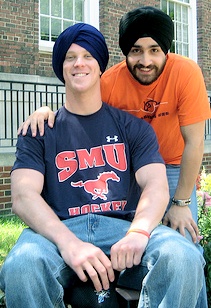Template:AOW199: Difference between revisions
Hari singh (talk | contribs) (New page: {{aowh|Turban day}} {{p|Image:International Turban Day-3.jpg|Volunteer and organiser show off their turbans}} '''International Turban Day''' was started in 2004 to bring awareness of ...) |
Hari singh (talk | contribs) No edit summary |
||
| Line 2: | Line 2: | ||
{{p|Image:International Turban Day-3.jpg|Volunteer and organiser show off their turbans}} | {{p|Image:International Turban Day-3.jpg|Volunteer and organiser show off their turbans}} | ||
'''International Turban Day''' was started in 2004 to bring awareness of the strict requirement on Sikhs to don the [[turban]] as a mandatory part of their religion. Since {{w|9/11}} in 2001, the turban has attracted negative attention due to the wrongful linking of this garment with {{w|Osama bin Laden}}, who is a [[Muslim]]. Due to the vast news coverage of Osama bin Laden following 9/11, everyone wearing a turban was looked upon as part of his clan or sect and considered to be [[Muslim]]. Despite this wrong perception, the vast majority of people who wear turbans in Western countries are actually [[Sikh]]s. | '''International Turban Day''' is celebrated on April 13th every year. This event was started in 2004 to bring awareness of the strict requirement on Sikhs to don the [[turban]] as a mandatory part of their religion. Since {{w|9/11}} in 2001, the turban has attracted negative attention due to the wrongful linking of this garment with {{w|Osama bin Laden}}, who is a [[Muslim]]. Due to the vast news coverage of Osama bin Laden following 9/11, everyone wearing a turban was looked upon as part of his clan or sect and considered to be [[Muslim]]. Despite this wrong perception, the vast majority of people who wear turbans in Western countries are actually [[Sikh]]s. | ||
The turban or "dastar" or "pagri" often shortened to "pag" are different words in various dialect for the same article. All these words refer to the garment worn by both men and women to cover their heads. It is a headdress consisting of a long scarf-like single piece of cloth wound round the head or sometimes an inner "hat" or [[patka]]. Traditionally in [[India]], the turban was only worn by men of high status in society; men of low status or of lower castes were not allowed or could not afford to wear a turban. | The turban or "dastar" or "pagri" often shortened to "pag" are different words in various dialect for the same article. All these words refer to the garment worn by both men and women to cover their heads. It is a headdress consisting of a long scarf-like single piece of cloth wound round the head or sometimes an inner "hat" or [[patka]]. Traditionally in [[India]], the turban was only worn by men of high status in society; men of low status or of lower castes were not allowed or could not afford to wear a turban. | ||
Since 2004, on Turban Day, Sikhs worldwide organise various events to give information about the turban to the general community in their locality. Turbans of every hue were represented at these events and posters highlighting information about Sikhi are also displayed and handed out. | |||
Turban tying session are arranged so that youngsters and others get a chance to wear a turban for the first time and have their photos taken. {{aowf|Turban day}} | |||
Revision as of 12:13, 1 April 2009
International Turban Day is celebrated on April 13th every year. This event was started in 2004 to bring awareness of the strict requirement on Sikhs to don the turban as a mandatory part of their religion. Since 9/11 in 2001, the turban has attracted negative attention due to the wrongful linking of this garment with Osama bin Laden, who is a Muslim. Due to the vast news coverage of Osama bin Laden following 9/11, everyone wearing a turban was looked upon as part of his clan or sect and considered to be Muslim. Despite this wrong perception, the vast majority of people who wear turbans in Western countries are actually Sikhs.
The turban or "dastar" or "pagri" often shortened to "pag" are different words in various dialect for the same article. All these words refer to the garment worn by both men and women to cover their heads. It is a headdress consisting of a long scarf-like single piece of cloth wound round the head or sometimes an inner "hat" or patka. Traditionally in India, the turban was only worn by men of high status in society; men of low status or of lower castes were not allowed or could not afford to wear a turban.
Since 2004, on Turban Day, Sikhs worldwide organise various events to give information about the turban to the general community in their locality. Turbans of every hue were represented at these events and posters highlighting information about Sikhi are also displayed and handed out.
Turban tying session are arranged so that youngsters and others get a chance to wear a turban for the first time and have their photos taken. .....More

